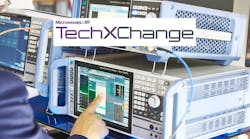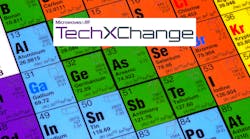The Microwaves & RF Industry Converges at IMS 2024
Check out our coverage of IMS 2024.
Members can download this article in PDF format.
What you’ll learn:
- IMS 2024 offers a veritable “department store” of RF/microwave-related products and services.
- On the show floor, see dozens of demonstrations of the latest products and technologies.
- IMS affords a golden opportunity to network with suppliers, customers, and even potential future employers.
Representing an industry that’s grown steadily with the world’s adoption of radio waves prior to World War II, the annual IEEE MTT-S International Microwave Symposium (IMS) offers the opportunity to catch up with friends and competitors. The exhibition floor is crowded with small and large RF/microwave companies and visitors hoping to learn more about their products and services.
For specifiers, the 2024 IMS Exhibition (June 18-20, 2024, Walter E. Washington Convention Center, Washington, DC) affords the chance to explore products that may make a difference in the latest communications, electronic-warfare (EW), radar, and other high-frequency systems. It’s a popular portion of the IEEE MTT-S International Microwave Symposium, which runs from June 16-21, 2024 and includes a host of practical educational events such as the Automatic RF Techniques Group (ARFTG) meeting to broaden RF/microwave measurement expertise.
The 2024 IMS Exhibition promises to simulate an RF/microwave “department store” of products and services, from the smallest semiconductor integrated circuits (ICs) and surface-mount-technology (SMT) components to complete systems and test-and-measurement equipment.
Walking the floor in hopes of finding a solution for a set of specifications for a design in progress takes time, especially with the many attention-grabbing booth displays promoting new levels of performance over extended frequency ranges. More companies than ever offer products into the millimeter-wave (mmWave) frequency range to meet the growing needs of applications such as 5G wireless communications networks and advanced driver-assistance system (ADAS) equipment.
Personnel at company booths on the IMS exhibition floor are typically knowledgeable and courteous, often presenting “live” demonstrations of new products under simulated working conditions. On the test-and-measurement side, booths at the IMS exhibition often contain new hardware and software for visitors to operate and evaluate with a connected device under test (DUT). Researchers can collect stacks of datasheets and application notes to assist with a future project.
With over 500 exhibitors, not all will be included in this short preview of the 2024 IMS Exhibition. But some exhibitors with recent product introductions are featured here, organized by product categories to aid specifiers in search of a particular product or service. As specifiers usually learn, walking a show floor with such a variety of products, many of them developed for introduction at the event, could easily take a day or two. But when the search leads to a meaningful relationship with a future supplier, it can be time well spent.
Components: MMICs, Filters, Passives, and Transmission Lines
Visitors in search of high-frequency active and passive components will find a sampling of one of the industry’s most comprehensive lineups at booth 1639 for Mini-Circuits. With a long history of reliable discrete and monolithic-microwave-integrated-circuit (MMIC) active and passive components, the company has built a sizable inventory of low-temperature-cofired-ceramic (LTCC) filters and switches, including surface-mount bandpass filters in packages as small as 0603 size.
Though best known as a component supplier, Mini-Circuits also offers practical test equipment such as the SSG-44G-RC signal generator (Fig. 1). Capable of pulsed and continuous-wave (CW) output signals from 0.1 to 44.0 GHz, the source features a dynamic range of −40 to +17 dBm. Controllable with a PC and free software via USB or Ethernet ports, it produces CW signals and pulses as narrow as 0.5 µs available at a 2.92-mm female connector. Typical phase noise is −102 dBc/Hz offset 10 kHz from a 10-GHz carrier.
Component specifiers will find an exhibit hall full of coaxial and SMT components at the 2024 IMS exhibition. They range from building-block components such as resistors, capacitors, and inductors from Kyocera AVX at booth 420 to a low-loss Butler matrix from Krytar at booth 1412 supporting beamforming and direction-finding (DF) systems from 0.5 to 40.0 GHz.
At booth 507, Herotek will show a variety of wideband amplifiers spanning 10 MHz to 20 GHz in drop-in packages. Among them is the AF0012073A low-noise amplifier (LNA) with 3-dB noise figure and 17-dB gain flat to ±1.0 dB from 10 MHz to 20 GHz. At booth 1931, Narda-Miteq will highlight components and integrated assemblies into the mmWave frequency range in support of 5G and radar systems.
Among its assortment of surface-acoustic-wave (SAW) filters and power amplifiers (PAs), at booth 1125, Qorvo US will display GaN-on-SiC technology with its model QPM1002 MMIC front-end module (FEM). For X-band radar systems from 8.5 to 10.5 GHz, it combines a low-noise amplifier (LNA), PA, and transmit/receiver (T/R) switch in a 5.0 × 5.0 mm, surface-mount QFN package (Fig. 2). It handles input signals as high as +33 dBm (2 W) without a limiter.
RF/microwave specifiers will find a diversified display of component solutions on an exhibition floor that includes trusted suppliers such as RLC Electronics at booth 1013 with mechanical switches and filters and Flann Microwave Ltd. at booth 1152 with passive waveguide components like adapters, power combiners/dividers, and transmission lines to 1.1 THz. Others include Communications & Power Industries at booth 1512 with amplifiers and traveling-wave tubes (TWTs) for high-power radars, and Micro Lambda Wireless next door at booth 1513 with electronically tunable YIG filters and oscillators.
RFICs, SIPs, SoCs, and Power Devices
Semiconductor-driven devices will be on display in many forms, from chip and packaged power transistors to system-in-package (SiP) and system-on-chip (SoC) devices. At booth 1239, Analog Devices will present some of its thermally efficient gallium-nitride (GaN) PA ICs as well as more highly integrated examples of its semiconductors like its new model ADSY1100 RF/microwave transceiver that operates to 20 GHz.
Housed in a compact package that meets Sensor Open Systems Architecture (SOSA) requirements, the transceiver includes Ethernet and Optical Ethernet computer interfaces to 100 Gb/s. It incorporates several high-performance field-programmable gate arrays (FPGAs). ADI’s AD9084 SoC transceiver packs four receivers and four transmitters in a 24- × 26-mm, 899-ball ball-grid-array (BGA) package.
At booth 445, Texas Instruments also offers a wide range of highly integrated semiconductor devices, including GaN power stages like the recently introduced LMG2100R044 and LMG3100R017 100-V devices. Designers seeking mmWave radar sensors for guidance in automotive and robotic systems can turn to the firm’s AWRL1432 and IWRL1432 single-chip 76- to 81-GHz radars that integrate multiple receive and transmit channels in miniature packages. Suitable for short-range applications, the devices have built-in power management, self-test, and calibration functionality.
With its acquisition of Wolfspeed late in 2023, MACOM (booth 921) added to its assortment of semiconductor products with GaN and GaN-on-silicon-carbide (GaN-on-SiC) RF power devices, both types capable of delivering high power outputs from small packages. As an example, the CGHV59350 GaN-on-SiC PA for 5.2- to 5.9-GHz C-band radar can be supplied in a ceramic-metal flange or pill package. It provides 10.7-dB power gain and 60% typical power-added efficiency (PAE) over that range while delivering 470-W typical pulsed output power.
At higher frequencies, the MAAP-001379 distributed PA employs gallium-arsenide (GaAs) pseudomorphic high-electron-mobility-transistor (pHEMT) technology for 22-dB linear gain and +30-dBm (1 W) saturated output power from 20 to 55 GHz. Additional high-power-density semiconductor devices can be found at Polyfet RF Devices’ booth 1815 with its silicon LDMOS and GaN FET devices.
PCBs, Laminates, and Packaging
Several of the IMS technical presentations explore the use of additive manufacturing and three-dimensional (3D) printing techniques to produce shape-sensitive circuits and components such as phased-array antennas. However, most specifiers at the exhibition will still need more traditional printed-circuit-board (PCB) materials.
They will find such options from the Advanced Electronics Solutions (AES) group of Rogers Corp. at booth 739. The company’s RO3010 and RO4003C laminates are widely used in RF/microwave circuits through mmWave frequencies. Ceramic-filled polytetrafluoroethylene (PTFE) RO3010 laminates are usable to 77 GHz with a dielectric constant (Dk) of 10.2 and low dissipation factor (Df) of 0.0022 at 10 GHz. For circuit designers preferring to start with a lower Dk, RO4003C laminates have a Dk of 3.38 with Df of 0.0027 at 10 GHz.
With even lower Df values, TerraGreen 400G and TerraGreen 400G2 laminates from Isola Group at booth 1821 are halogen-free materials that support analog PCBs into the mmWave frequency range and digital circuits at speeds to 100 Gb/s and more. The glass-filled circuit materials can be processed with FR-4 methods and standard PCB fabrication equipment.
TerraGreen 400G, with a typical Dk of 3.15 at 10 GHz, has a typical Df of 0.0017. It features a high-temperature composition, with glass transition temperature (Tg) of typically +200°C and decomposition temperature (Td) of typically +380°C. TerraGreen 400G2, the company’s latest circuit material for 5G systems, high-end computing, and advanced wireless communications, has a typical Dk of 3.10 at 10 GHz with Df of typically 0.0015. Both circuit materials support PCBs with data rates past 100 Gb/s.
When faced with designing and producing large, multilayer circuits based on flexible and rigid circuit materials, Amphenol Printed Circuits at booth 1004 provides the capabilities and experience to handle designs with as many as 70 circuit layers.
At booth 1015, Northrop Grumman will be showing its novel hypersonic materials. Handling speeds greater than 1 mile/s, these materials must withstand temperatures exceeding +2000°F for hypersonic missiles as well as counter-hypersonic systems. Although showing materials, Northrop Grumman is well-known as a systems house and represents one of many systems suppliers at the 2024 IMS exhibition, including Mercury Systems at booth 1332, Teledyne Technologies at booth 1021, and The Boeing Co. at booth 2051.
CAD Software: FEA, SI, and EMI Analysis
RF/microwave engineers in need of computer-aided-design (CAD) software can compare a variety of programs at the 2024 IMS exhibition from many developers, including Ansys in booth 621, Cadence Design Systems in booth 1321, COMSOL in booth 446, MathWorks in booth 2139, and Sonnet Software in booth 606. For example, among its many finite-element-analysis (FEA) software tools, Ansys will show SiWave software for signal-integrity (SI) analysis, power-integrity analysis, and EMI analysis of IC packages and PCBs.
COMSOL MultiPhysics software can adapt to different forms of computer analysis with add-on modules that support functions such as mechanical and thermal analysis. MathWorks will demonstrate several of its math-based tools, such as MATLAB and Simulink. And Sonnet’s EM-based simulators are well-established for modeling high-frequency analog and high-speed digital PCBs.
Although best known for its test equipment, Keysight Technologies in booth 721 will also contribute to a strong CAE software showing at the exhibition. Its EM-analysis-based Pathwave ADS 2024 for RF & Microwave Circuit Design is well-suited for modeling ICs and highly integrated modules through mmWave frequencies.
RF Test & Measurement: VNAs, Signal Generators, and Scopes
In addition to powerful design software, Keysight will be leading a strong lineup of test-equipment suppliers at the 2024 IMS exhibition. Along with its audio analyzers, digital storage oscilloscopes (DSOs), signal generators, and spectrum analyzers, Keysight will invite visitors to see its PNA family of vector network analyzers (VNAs), which feature impressive 110-dB dynamic range through mmWave frequencies. The PNA N5290A two- and four-port VNAs operate from 900 Hz to 110 GHz while the PNA N5291A two- and four-port VNAs add frequency extenders for coverage from 900 Hz to 120 GHz.
In booth 704, Maury Microwave will show examples of its load-pull systems working with VNAs. And in booth 729, Marvin Test Solutions will show its digital multimeters (DMMs) and source measure units (SMUs) in PXI form.
Known for portable spectrum analyzers and digital storage oscilloscopes (DSOs), Tektronix will generate test signals in booth 2205 with its AWG70000B Series arbitrary waveform generators (AWGs). Models operate to 50 Gsamples/s with better than 20-GHz bandwidths and 10-bit resolution. Programmable signals exhibit −80-dBc spurious-free dynamic range (SFDR).
For spectrum analyzer enthusiasts, Signal Hound will show its compact but powerful SM435C spectrum analyzer (Fig. 3) with frequency range of 100 kHz to 43.5 GHz in booth 1209.
The exhibition floor will abound with test-equipment demonstrations from many notable suppliers. They include Anritsu with Spectrum Master portable spectrum analyzers to 170 GHz at booth 1039, Boonton Electronics with RF power meters at booth 704, Copper Mountain Technologies with USB VNAs at booth 1111, Focus Microwaves with mmWave load-pull tuners at booth 439, GGB Industries with 110-GHz Picoprobe probe cards at booth 642, and Rohde & Schwarz with mmWave component testers at booth 1521.
For an industry event with over 500 exhibitors, visiting every booth in two-and-a-half days may end up as not much more than a wave of the hand at each booth. But with a specifier’s approach, lists of requirements can be turned into potential solutions and future professional relationships.
Check out more of our coverage of IMS 2024. Also read more articles in the TechXchanges: PCB Tools and Technology, Passives & Parts, Wide-Bandgap Semiconductors, and 5G Test and Measurement.
About the Author
Jack Browne
Technical Contributor
Jack Browne, Technical Contributor, has worked in technical publishing for over 30 years. He managed the content and production of three technical journals while at the American Institute of Physics, including Medical Physics and the Journal of Vacuum Science & Technology. He has been a Publisher and Editor for Penton Media, started the firm’s Wireless Symposium & Exhibition trade show in 1993, and currently serves as Technical Contributor for that company's Microwaves & RF magazine. Browne, who holds a BS in Mathematics from City College of New York and BA degrees in English and Philosophy from Fordham University, is a member of the IEEE.







